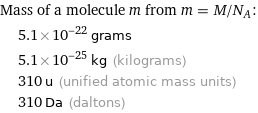Input interpretation

hexaammineruthenium(III) chloride | molar mass
Result
![Find the molar mass, M, for hexaammineruthenium(III) chloride: M = sum _iN_im_i Plan: • Write the chemical formula and gather atomic masses from the periodic table. • Determine values for N_i and m_i using these items. • Finally, compute the mass. Write the chemical formula: [Ru(NH_3)_6]Cl_3 Use the chemical formula to count the number of atoms, N_i, for each element: | N_i Cl (chlorine) | 3 H (hydrogen) | 18 N (nitrogen) | 6 Ru (ruthenium) | 1 Look up the atomic mass, m_i, in g·mol^(-1) for each element in the periodic table: | N_i | m_i/g·mol^(-1) Cl (chlorine) | 3 | 35.45 H (hydrogen) | 18 | 1.008 N (nitrogen) | 6 | 14.007 Ru (ruthenium) | 1 | 101.07 Multiply N_i by m_i to compute the mass for each element. Then sum those values to compute the molar mass, M: Answer: | | | N_i | m_i/g·mol^(-1) | mass/g·mol^(-1) Cl (chlorine) | 3 | 35.45 | 3 × 35.45 = 106.35 H (hydrogen) | 18 | 1.008 | 18 × 1.008 = 18.144 N (nitrogen) | 6 | 14.007 | 6 × 14.007 = 84.042 Ru (ruthenium) | 1 | 101.07 | 1 × 101.07 = 101.07 M = 106.35 g/mol + 18.144 g/mol + 84.042 g/mol + 101.07 g/mol = 309.61 g/mol](../image_source/65e80bb288813f2de160fbcc6051a349.png)
Find the molar mass, M, for hexaammineruthenium(III) chloride: M = sum _iN_im_i Plan: • Write the chemical formula and gather atomic masses from the periodic table. • Determine values for N_i and m_i using these items. • Finally, compute the mass. Write the chemical formula: [Ru(NH_3)_6]Cl_3 Use the chemical formula to count the number of atoms, N_i, for each element: | N_i Cl (chlorine) | 3 H (hydrogen) | 18 N (nitrogen) | 6 Ru (ruthenium) | 1 Look up the atomic mass, m_i, in g·mol^(-1) for each element in the periodic table: | N_i | m_i/g·mol^(-1) Cl (chlorine) | 3 | 35.45 H (hydrogen) | 18 | 1.008 N (nitrogen) | 6 | 14.007 Ru (ruthenium) | 1 | 101.07 Multiply N_i by m_i to compute the mass for each element. Then sum those values to compute the molar mass, M: Answer: | | | N_i | m_i/g·mol^(-1) | mass/g·mol^(-1) Cl (chlorine) | 3 | 35.45 | 3 × 35.45 = 106.35 H (hydrogen) | 18 | 1.008 | 18 × 1.008 = 18.144 N (nitrogen) | 6 | 14.007 | 6 × 14.007 = 84.042 Ru (ruthenium) | 1 | 101.07 | 1 × 101.07 = 101.07 M = 106.35 g/mol + 18.144 g/mol + 84.042 g/mol + 101.07 g/mol = 309.61 g/mol
Unit conversion

0.3096 kg/mol (kilograms per mole)
Comparisons

≈ 0.43 × molar mass of fullerene ( ≈ 721 g/mol )

≈ 1.6 × molar mass of caffeine ( ≈ 194 g/mol )

≈ 5.3 × molar mass of sodium chloride ( ≈ 58 g/mol )
Corresponding quantities

Mass of a molecule m from m = M/N_A: | 5.1×10^-22 grams | 5.1×10^-25 kg (kilograms) | 310 u (unified atomic mass units) | 310 Da (daltons)

Relative molecular mass M_r from M_r = M_u/M: | 310